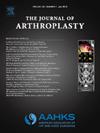下肢动脉钙化预测初次全髋关节置换术后转入封闭病房的风险
IF 3.4
2区 医学
Q1 ORTHOPEDICS
引用次数: 0
摘要
背景:我们旨在确定初级全髋关节置换术(THA)患者的下肢动脉钙化(LEAC)与转入封闭病房(CU)、住院时间、90 天再入院率和 1 年死亡率之间的关系:我们回顾性分析了705名接受初级全髋关节置换术的患者,其中64名患者(9.13%)接受了LEAC,641名患者未接受LEAC。接受LEAC的患者年龄更大(77 ± 10.0岁对67 ± 11.5岁;P < 0.001),合并症更多,但血栓栓塞和肿瘤疾病史除外(P > 0.05)。术前骨盆前后位X光片用于评估是否存在LEAC。记录了入院情况、住院时间、90 天再入院情况和 1 年死亡率。采用逻辑回归模型确定转诊至CU的风险因素:结果:LEAC 患者入住重症监护室的比例更高(64 例中的 8 例 [12.5%] 与 641 例中的 8 例 [1.09%];P < 0.001),住院时间更长(4.7 ± 1.8 天与 4.2 ± 1.3 天;P = 0.与未接受 LEAC 治疗的患者相比,接受 LEAC 治疗的患者住院时间更长(4.7 ± 1.8 天对 4.2 ± 1.3 天;P = 0.006)、再入院次数更多(64 例中有 16 例 [25%] 对 641 例中有 33 例 [5.15%];P < 0.001)、1 年死亡率更高(64 例中有 6 例 [9.3%] 对 641 例中有 0 例 [0%];P < 0.001)。在中大收治的 LEAC 患者中,8 人中仅有 3 人在麻醉科进行的术前评估中曾有进行 LEAC 的指征,而所有转诊至中大的非 LEAC 患者均有进行 LEAC 的指征。逻辑回归分析表明,LEAC 是入住 CU 的一个风险因素(几率比 [OR] = 4.77;95% 置信区间 [CI]:1.12-20.25,1.12-20.25):结论:结论:LEAC的存在是导致转入CU、住院时间延长、再入院次数增加和1年死亡率升高的风险因素。识别LEAC患者有助于对计划接受初级THA的患者进行术前评估和风险分层。本文章由计算机程序翻译,如有差异,请以英文原文为准。
Lower Extremity Arterial Calcification Predicts Referral to a Closed Unit After Primary Total Hip Arthroplasty
Background
We aimed to determine the association between lower extremity arterial calcification (LEAC) and referral to a closed unit (CU), length of stay, 90-day readmissions, and 1-year mortality in primary total hip arthroplasty (THA) patients.
Methods
We retrospectively analyzed 705 patients who underwent primary THA, identifying 64 patients (9.13%) who had LEAC and 641 who did not have LEAC. Patients who had LEAC were older (77 ± 10.0 versus 67 ± 11.5 years; P < 0.001) and had more comorbidities, except for a history of thromboembolic and oncologic diseases (P > 0.05). A preoperative antero-posterior pelvic radiograph was used to assess the presence of LEAC. Admission to CU, length of stay, 90-day readmissions, and 1-year mortality were recorded. A logistic regression model was used to identify risk factors for referral to CU.
Results
Patients who had LEAC had a higher incidence of admission to the intensive care unit (8 of 64 [12.5%] versus 8 of 641 [1.09%]; P < 0.001), a longer hospital stay (4.7 ± 1.8 versus 4.2 ± 1.3 days; P = 0.006), more readmissions (16 of 64 [25%] versus 33 of 641 [5.15%]; P < 0.001), and a higher 1-year mortality rate (6 of 64 [9.3%] versus 0 of 641 [0%]; P < 0.001) than patients who did not have LEAC. Of the patients who had LEAC admitted to CU, only 3 of 8 had a previous indication to do so in the preoperative assessment performed by the Department of Anesthesiology, while all non-LEAC ones referred to CU did so. Logistic regression analysis showed that LEAC was a risk factor for admission to CU (odds ratio = 4.77; 95% confidence interval: 1.12 to 20.25; P = 0.034).
Conclusions
The presence of LEAC was a risk factor for transfer to CU, longer in-hospital stays, more readmissions, and a higher 1-year mortality rate. Identifying patients who have LEAC can aid in the preoperative assessment and risk stratification of patients planned for primary THA.
求助全文
通过发布文献求助,成功后即可免费获取论文全文。
去求助
来源期刊

Journal of Arthroplasty
医学-整形外科
CiteScore
7.00
自引率
20.00%
发文量
734
审稿时长
48 days
期刊介绍:
The Journal of Arthroplasty brings together the clinical and scientific foundations for joint replacement. This peer-reviewed journal publishes original research and manuscripts of the highest quality from all areas relating to joint replacement or the treatment of its complications, including those dealing with clinical series and experience, prosthetic design, biomechanics, biomaterials, metallurgy, biologic response to arthroplasty materials in vivo and in vitro.
 求助内容:
求助内容: 应助结果提醒方式:
应助结果提醒方式:


